10 rupee: Mahatma Gandhi birth centenary 1969
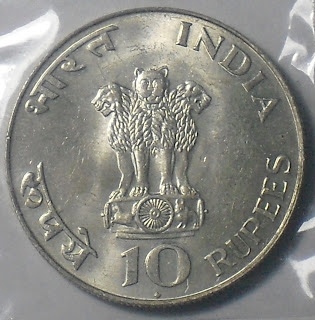
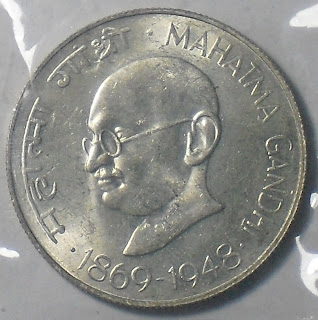 Any description of India's history in the British era can never be complete without the mention of Mohandas Karamchand Gandhi, better known as Mahatma Gandhi. Mahatma Gandhi was born in 1869 in Porbandar in Gujrat, and died in 1948 when he was shot by Nathuram Godse. Mahatma Gandhi was one who preached non-violence in an era of violence, world wars and all and successully led the country to independence through non-violent means like protests etc.
Any description of India's history in the British era can never be complete without the mention of Mohandas Karamchand Gandhi, better known as Mahatma Gandhi. Mahatma Gandhi was born in 1869 in Porbandar in Gujrat, and died in 1948 when he was shot by Nathuram Godse. Mahatma Gandhi was one who preached non-violence in an era of violence, world wars and all and successully led the country to independence through non-violent means like protests etc.The Gandhis belong to the Bania caste and seem to have been originally grocers. But for three generations, from Mahatama Gandhi's grandfather, they have been Prime Ministers in several Kathiawad States. Uttamchand Gandhi, alias Ota Gandhi, was his grandfather.
Ota Gandhi married a second time, having lost his first wife. He had four sons by his first wife and two by his second wife.. The fifth of these six brothers was Karamchand Gandhi, alias Kaba Gandhi, and the sixth was Tulsidas Gandhi. Both these brothers were Prime Ministers in Porbandar, one after the other. Kaba Gandhi was Mahatma Gandhi's father. He was a member of the Rajasthanik Court. It is now extinct, but in those days it was a very influential body for settling disputes between the chiefs and their fellow clansmen.
Kaba Gandhi married four times in succession, having lost his wife each time by death. He had two daughters by his first and second marriages. His last wife, Putlibai, bore him a daughter and three sons, Mahatma Gandhi being the youngest.
Gandhi remained in South Africa for twenty years, suffering imprisonment many times. In 1896, after being attacked and humiliated by white South Africans, Gandhi began to teach a policy of passive resistance to, and non-cooperation with, the South African authorities. Part of the inspiration for this policy came from the Russian writer Leo Tolstoy, whose influence on Gandhi was profound. Gandhi also acknowledged his debt to the teachings of Christ and to the 19th-century American writer Henry David Thoreau, especially to Thoreau's famous essay "Civil Disobedience." Gandhi considered the terms passive resistance and civil disobedience inadequate for his purposes, however, and coined another term, Satyagraha (from Sanskrit, "truth and firmness"). During the Boer War, Gandhi organized an ambulance corps for the British army and commanded a Red Cross unit. After the war he returned to his campaign for Indian rights. In 1910, he founded Tolstoy Farm, near Durban, a cooperative colony for Indians. In 1914 the government of the Union of South Africa made important concessions to Gandhi's demands, including recognition of Indian marriages and abolition of the poll tax for them. His work in South Africa complete, he returned to India.
Then Gandhi became a leader in a complex struggle, the Indian campaign for home rule. Following World War I, in which he played an active part in recruiting campaigns, Gandhi, again advocating Satyagraha, launched his movement of non-violent resistance to Great Britain. When, in 1919, Parliament passed the Rowlatt Acts, giving the Indian colonial authorities emergency powers to deal with so-called revolutionary activities, Satyagraha spread throughout India, gaining millions of followers. A demonstration against the Rowlatt Acts resulted in a massacre of Indians at Amritsar by British soldiers; in 1920, when the British government failed to make amends, Gandhi proclaimed an organized campaign of non-cooperation. Indians in public office resigned, government agencies such as courts of law were boycotted, and Indian children were withdrawn from government schools. Throughout India, streets were blocked by squatting Indians who refused to rise even when beaten by police. Gandhi was arrested, but the British were soon forced to release him. Gandhi advocate economic independence by boycotting English goods.
Gandhi became the international symbol of a free India. He lived a spiritual and ascetic life of prayer, fasting, and meditation. His union with his wife (Kasturba Gandhi) became, as he himself stated, that of a brother and sister. Refusing earthly possessions, he wore the loincloth and shawl of the lowliest Indian and subsisted on vegetables, fruit juices, and goat's milk. Indians revered him as a saint and began to call him Mahatma (great-souled), a title reserved for the greatest sages. Gandhi's advocacy of nonviolence, known as ahimsa (non-violence), was the expression of a way of life implicit in the Hindu religion. By the Indian practice of nonviolence, Gandhi held, Great Britain too would eventually consider violence useless and would leave India.
When World War II broke out, the Congress party and Gandhi demanded a declaration of war aims and their application to India. As a reaction to the unsatisfactory response from the British, the party decided not to support Britain in the war unless the country were granted complete and immediate independence. The British refused, offering compromises that were rejected. When Japan entered the war, Gandhi still refused to agree to Indian participation. He was interned in 1942 but was released two years later because of failing health.
By 1944 the Indian struggle for independence was in its final stages, the British government having agreed to independence on condition that the two contending nationalist groups, the Muslim League and the Congress party, should resolve their differences. Gandhi stood steadfastly against the partition of India but ultimately had to agree, in the hope that internal peace would be achieved after the Muslim demand for separation had been satisfied. India and Pakistan became separate states when the British granted India its independence in 1947 (see: Tryst with Destiny -- the story of India's independence). During the riots that followed the partition of India, Gandhi pleaded with Hindus and Muslims to live together peacefully. Riots engulfed Calcutta, one of the largest cities in India, and the Mahatma fasted until disturbances ceased. On January 13, 1948, he undertook another successful fast in New Delhi to bring about peace, but on January 30, 12 days after the termination of that fast, as he was on his way to his evening prayer meeting, he was assassinated by a fanatic Hindu, Nathuram Godse.
Gandhi's death was regarded as an international catastrophe. His place in humanity was measured not in terms of the 20th century, but in terms of history. A period of mourning was set aside in the United Nations General Assembly, and condolences to India were expressed by all countries. Religious violence soon waned in India and Pakistan, and the teachings of Gandhi came to inspire nonviolent movements elsewhere, notably in the U.S.A. under the civil rights leader Martin Luther King, Jr. and in South Africa under Nelson Mandela.
Even though the greatness of Mahatma Gandhi as a leader and his impact on India's and even world's history is indisputable and unquestionable, yet there was a faction of revolutionaries in India who believed that if Gandhi had not been in the picture, there would have been a popular uprising in India and the British would have have thrown out of India long before 1947, when India eventually got its independence.
This coin was just one in a series of commemorative coins that were issued in 1969 which happens to be the centenary of Mahatma Gandhi's birth. Coins of denomination 20 paisa and 50 paisa were also minted, not to mention a 1 rupee coin of republic india.
See also:
Mahatma Gandhi 20 paise
Mahatma Gandhi 50 paise
Mahatma Gandhi 1 rupee
10 rupee food for all
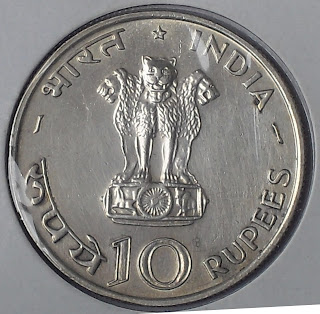
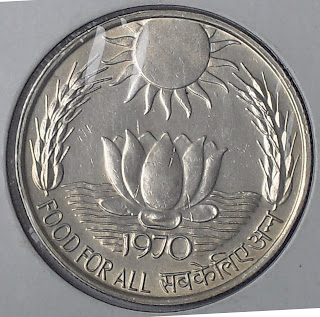
10 rupee: 25 years of independence

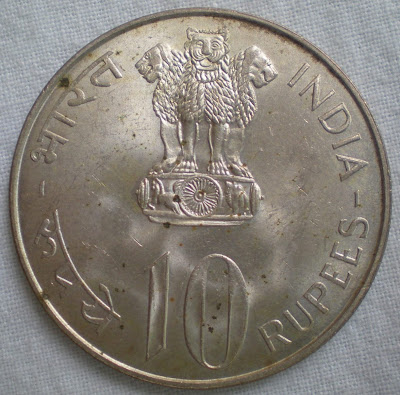
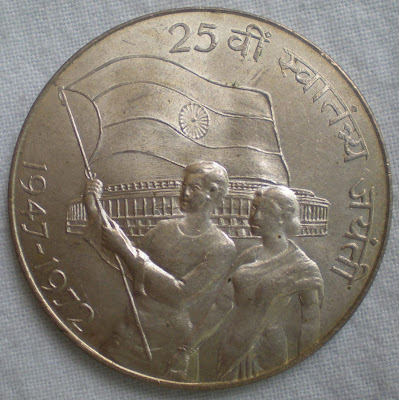
No comments:
Post a Comment